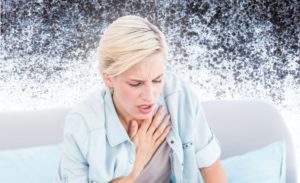Although Covid-19 Coronavirus and mold are completely unrelated things structurally, they bear a significant similarity in their effect and prevention in humans.
What is The Difference Between Covid-19 and Mold?
Covid-19 is a virus, which is different than a bacteria, and different than mold.
Mold (also known as mildew) is a fungus, like mushrooms.

Covid-19 Symptoms
- Fever or chills
- Cough
- Shortness of breath or difficulty breathing
- Fatigue
- Muscle or body aches
- Headache
- New loss of taste or smell
- Sore throat
- Congestion or runny nose
- Nausea or vomiting
- Diarrhea
- Trouble breathing
- Persistent pain or pressure in the chest
- New confusion
- Inability to wake or stay awake
- Bluish lips or face
Mold Symptoms
- Fever or chills
- Cough
- Sore throat
- Congestion
- Shortness of breath or difficulty breathing
- Headache
- Rash
- Confusion
- Memory loss
- Cancer

Transmission of Covid-19 and Mold
Both are transmitted via airborne means – particles in the case of Covid, and spores in the case of mold. They both have to enter the person’s respiratory system to affect them. Mold on a wall surface or Coronavirus inside another person will not affect anyone unless it enters their nose, mouth or ear canals. The main difference is that Covid-19 is transmitted from one person to another, while mold resides in the air currents of building and is transmitted simply by a person breathing in that building.
Precautions Against Covid-19 and Mold
But dangerous elements for drinking are not the whole story. Some elements may not harm your digestive or urinary systems, but they may harm your house’s plumbing system. Highly acidic water (Low PH) can cause the pipes to corrode and leak. High iron in the water can cause rust to form inside plumbing fixtures and destroy toilets as well as stain sinks and the interior of pipes and valves. Very hard water can make soap and detergents difficult to dissolve which complicates laundry and dishwashing. In the case of municipal water, the water being delivered to your taps is usually safe. It is tested on a regular basis and in some communities, a report is issued on a quarterly basis to the residents.
Mold in the Age of Covid-19
Since the pandemic has caused many people to work from home, take online school classes, and generally spend most of their time at home, it has also caused a greater awareness of mold in their homes. The room in the basement that someone never ventured into that now became an office has now been found to have a moldy odor and black spots on the wall. The use of storage items in the attic has suddenly caused occupants to notice discoloration on the sheathing and rafters. And prolonged occupancy in the home has caused greater ambient moisture to accumulate in the house via cooking, showering, perspiration, laundry and other things, and mold is attracted to water.

Safety Prevention Against Covid-19 and Mold
While guarding against Covid-19 vis-à-vis wearing a mask, washing one’s hands and social distancing is well known by now, the greatest safeguard against getting sick from airborne mold is to have it tested.
This is done by contacting a licensed mold assessor such as Certified Inspections, Inc. They will take air and swab samples and let you know if you and your family are in any danger from mold exposure. Like Covid-19, mold does not have to be seen for it to infect you. The spores are invisible and float in the air currents. It is wise and prudent to protect yourself from mold by scheduling a mold assessment.

